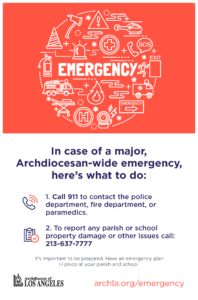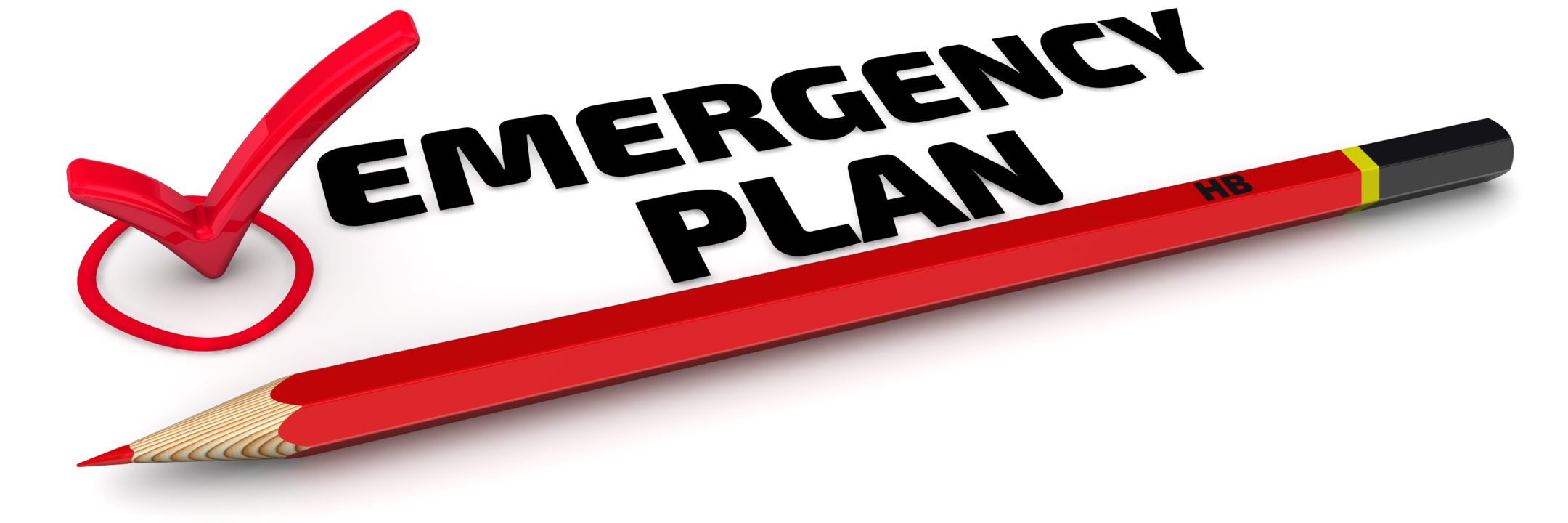 Click here to review emergency procedures in the ADLA handbook.
Click here to review emergency procedures in the ADLA handbook. - Supplies, including food and water
- A plan to reunite with friends and family members
- Communication, including alerts from city and county governments
- DUCK – get down where you are
- COVER – shelter, most likely underneath your desk or table, and away from windows that can shatter
- HOLD – hold on to the table leg, since the earth and your furniture may move. It is also known as Drop – Cover – Hold On.
Additional earthquake information is available (from the Southern California Earthquake Center at the University of Southern California) at: http://www.shakeout.org/dropcoverholdon/ and at: http://earthquakecountry.org.
You will also want to stay away from windows, which may break. Please look around your work area and determine a good place for you to duck, cover, and hold in case of an earthquake. Also, please be attentive to, for example, pictures on the wall that may fall down. Anchor tall bookcases to the walls or pillars. One item to note: Check to see if heavy items, like plants in large ceramic pots, are on top of file cabinets. In an earthquake, they will not just fall. They could become projectiles, and fly and hurt people. Please take note of this and relocate them. The same holds true for other heavy items on top of file cabinets, including big, heavy boxes.
Unlike a fire, immediate evacuation is not called for in the case of an earthquake, and may even be dangerous. The building or its contents may be moving. Also, with broken windows and glass shards, going out into the street may be dangerous or impossible. If there is a tall building nearby, you could be surrounded by six to seven feet of broken glass, so evacuation may not be possible, even for days.
With possible infrastructure damage, how would you get to work (or get back home) if your car was unavailable, or if your normal route was disrupted? You might want to consider the option of public transportation, or at least familiarize yourself with its possibilities in case you need to use it. You can contact the Los Angeles Metropolitan Transportation Authority at 323-GO-METRO, which is 323-466-3876, or at:http://www.metro.net
Fire:
With a fire, there may be a call for a building evacuation. If so, please follow the direction of your colleagues who are the members of the Emergency Team, since they will direct you as to how to evacuate. For example, do not try to take an elevator (either the passenger elevators or the freight elevator) in order to evacuate. Use the stairwells. Use the inside handrail, since it is continuous (and you can hold on even if smoke obscures your vision). The firefighters will be coming up on the outside. Once the fire department is on site, they are in charge, so follow their directions.
If you do need to evacuate the building (after the shaking has stopped or in case of a fire or even when we have drills), please bring your purse, wallet, car keys, house keys, cell phone, etc. with you. If the building is red-tagged as dangerous and unfit for occupation, the fire department will not let you back into the building, even if it is only to retrieve these items. Take them with you whenever you leave the building.
Active Shooter:
With respect to active shooters, the appropriate response (in order of highest preference to lowest preference): RUN – HIDE – FIGHT.
The City of Houston has a useful six-minute video that is used for training by the L.A.P.D. and the F.B.I. It has over eight million views. Find the video (which may be preceded by a brief advertisement) here.
Supplies:
If there is a serious emergency, you should be prepared to shelter in place for a time. That means you should have your own kit at your desk. It should contain:
- Food
- Water
- Shelter (blanket, for example)
- Light source (light stick or flashlight with batteries, but not candles or any open flame)
- First aid supplies
You may also want to include: a good pair of walking shoes, a radio, and contact information for friends or family members. Please consider making another kit for your car. While in the past people were directed to have three days’ worth of supplies, officials are now recommending five or even seven days’ worth, since rescue workers may not be able to get to people for that length of time, even in metropolitan areas such as Los Angeles.You may also want to have additional food, water blankets and cots, as well as light sticks and accommodations for toilets.
Resources and Information from Government and the Red Cross:
Information is also available on the website of the American Red Cross. A checklist of supplies for a disaster survival kit is at: http://www.redcross.org/prepare/location/home-family/get-kit
(You can scroll down the page to find the checklist of supplies.)
http://emergency.lacity.org/get-prepared
http://emergency.lacity.org/notifyla
http://lacoa.org/ (Los Angeles County Operational Area)
https://www.ventura.org/emergency-services/
http://countyofsb.org/ceo/sbcoem.sbc

